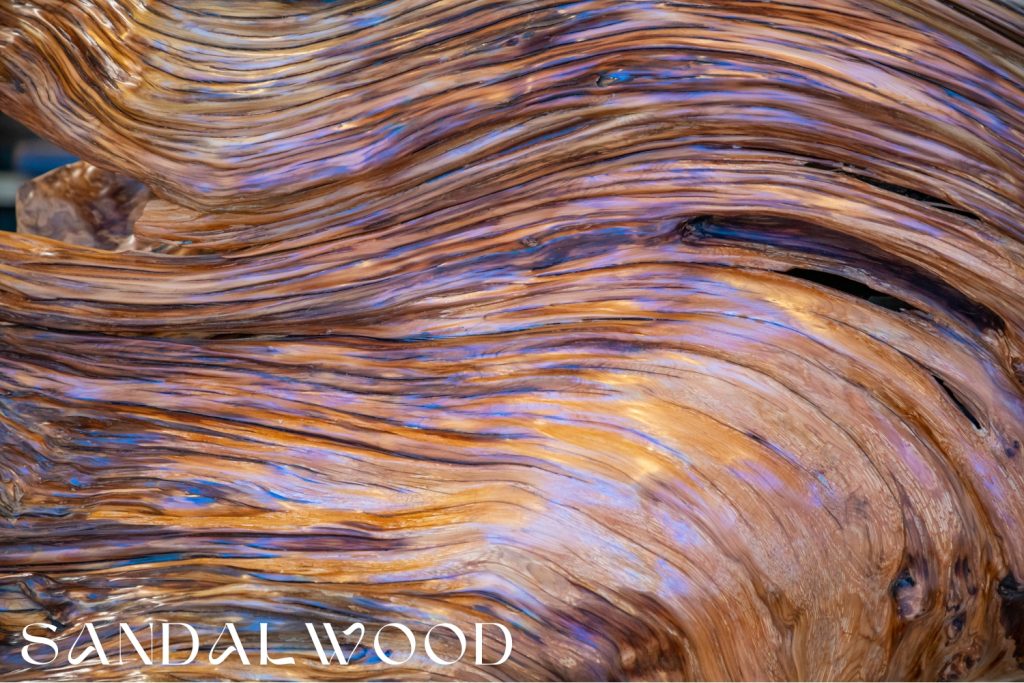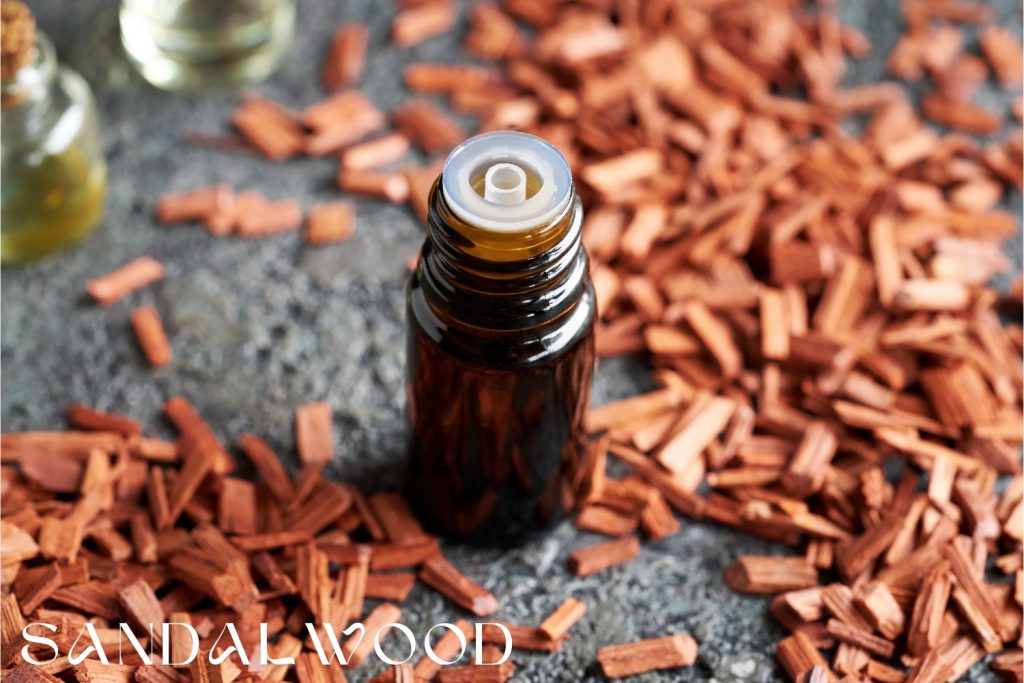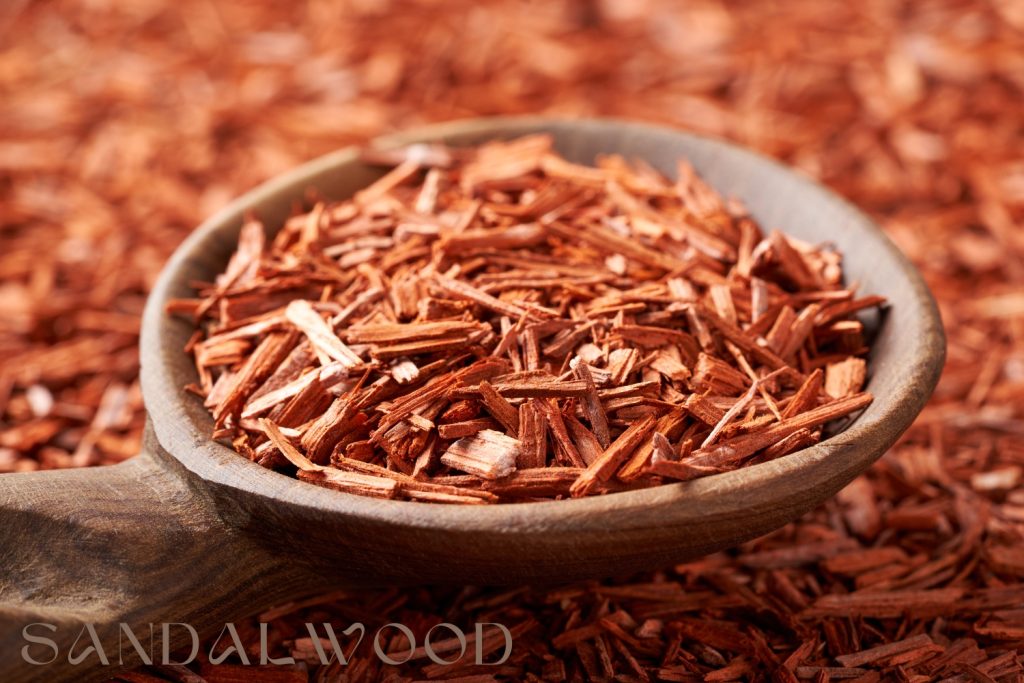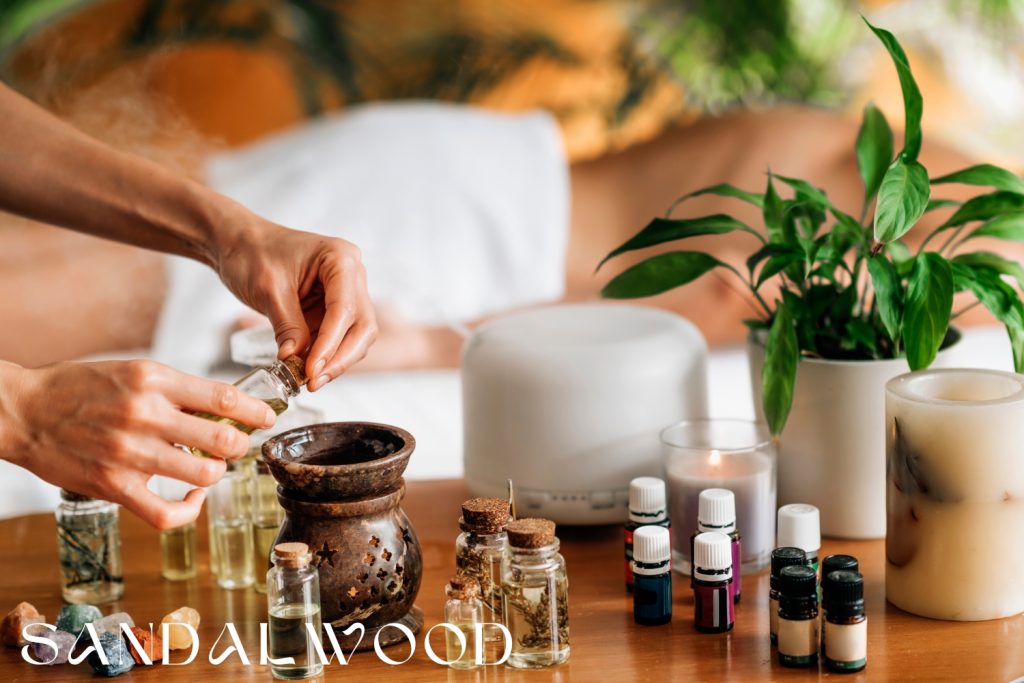Sandalwood essential oil is derived from the wood and roots of the sandalwood tree, a highly valued botanical known for its aromatic and therapeutic qualities. Renowned for its rich, woody scent, sandalwood oil is a staple in traditional medicine and perfumery. Its applications range from use in fragrances and cosmetics to potential health benefits, including supporting mental well-being and offering anti-inflammatory properties.
The oil possesses compounds that contribute to its reputed health effects, and researchers have studied it for various uses from skin care treatments to its potential role in relieving anxiety and promoting calmness. However, while it is celebrated for these benefits, it is also important to consider its appropriate usage and possible side effects. Like all essential oils, sandalwood oil should be used with awareness of the recommended dosages and potential reactions, especially for those with sensitive skin or specific allergies.

Key Takeaways
- Sandalwood essential oil is valued for its multifaceted benefits, including use in aromatherapy and skin care.
- The oil is believed to have anti-inflammatory and calming effects, addressing both physical and mental health aspects.
- It is vital to use sandalwood oil safely, being mindful of dosages and individual reactions to avoid adverse side effects.
History and Origins
Sandalwood oil is derived from the heartwood of various species of sandalwood trees, notably Santalum album for Indian sandalwood and Santalum spicatum for Australian sandalwood. Esteemed for its fragrance and durability, sandalwood has played a significant role in religious ceremonies, traditional Chinese medicine, and Ayurveda.
Traditional Uses
Indian Sandalwood (Santalum album), has been revered in Ayurvedic medicine for centuries. It was traditionally used to enhance meditation, with its calming aroma believed to help quiet the mind. Moreover, sandalwood’s cooling properties were sought for skincare and soothing inflammatory conditions.
Australian Sandalwood (Santalum spicatum), while similar to its Indian counterpart, has also been used traditionally, though it is not as highly prized as Santalum album. The indigenous people of Australia have utilized this species for spiritual rituals and as a remedy for skin ailments and respiratory issues.
In religious ceremonies across various cultures, sandalwood’s scent is integral during rites and rituals. Its inclusion in religious practices is linked to its purported ability to help with mental clarity and spiritual focus.
Traditional Chinese Medicine also recognized sandalwood’s merits. Practitioners have historically used it to treat various ailments, from digestive issues to skin conditions to mental health disturbances, thanks to its supposed antiviral and anti-inflammatory properties.
Extraction and Composition

Sandalwood oil is known for its rich, woody aroma and is extracted from the wood and roots of the sandalwood tree using a precise method. The quality of the oil is largely dependent on its composition and the extraction process used to isolate it.
Steam distillation is the primary process for extracting sandalwood essential oil. During steam distillation, high-temperature steam is passed through the sandalwood, causing the essential oil to evaporate. This vapor, which contains the oil, is then condensed back into a liquid form and separated from the water. The result is pure sandalwood essential oil that retains the natural compounds responsible for its desirable properties.
Essential Oil Profile
Botanical Name: Santalum album
Common Names: Sandalwood, Indian Sandalwood
Plant Family: Santalaceae
Countries of Origin: Sandalwood is native to India, but it is also cultivated in other parts of Asia, including Sri Lanka, Indonesia, and Australia.
Extraction Method: Sandalwood essential oil is typically extracted through steam distillation of the heartwood (the inner core of the trunk) of mature sandalwood trees.
Parts Used: Heartwood
Essential Oil Smell: Sandalwood essential oil has a rich, warm, creamy, and sweet aroma with woody, earthy, and slightly floral undertones. It is often described as exotic, sensual, and meditative.
Essential Oil Color: Pale yellow to golden yellow.
Viscosity: Medium
Perfumery Note: Base Note
Strength of Aroma: Medium to Strong
Blends Well With
- Floral oils like rose and jasmine
- Woody oils such as cedarwood and vetiver
- Citrus oils like bergamot and grapefruit
- Spice oils like clove and black pepper
Therapeutic Properties
- Relaxant
- Antidepressant
- Antiseptic
- Anti-inflammatory
- Antispasmodic
- Astringent
Uses
- Aromatherapy: Sandalwood oil is used in aromatherapy to promote relaxation, reduce stress and anxiety, and enhance mental clarity and focus. It is often diffused or used in massage blends.
- Perfumery: Sandalwood oil is highly valued in perfumery for its rich and exotic fragrance. It is used as a base note in many luxury perfumes, colognes, and fragrances.
- Skincare: Due to its soothing and skin-nourishing properties, sandalwood oil is used in skincare products to help moisturize, soften, and rejuvenate the skin.
- Meditation: Sandalwood oil is used in spiritual practices and meditation to create a peaceful and grounded atmosphere, enhance concentration, and deepen relaxation.
Contraindications
- Sandalwood oil is generally safe for topical and aromatic use. However, individuals with sensitive skin should perform a patch test before using it topically, as it may cause irritation in some people.
- Pregnant and breastfeeding women should consult with a healthcare professional before using sandalwood oil, although it is generally considered safe when used in moderation.
Side Effects
- In rare cases, sandalwood oil may cause skin irritation or allergic reactions. Discontinue use if any adverse reactions occur.
- Avoid ingesting sandalwood oil as it can be toxic and may cause gastrointestinal upset.
Types
- There are several species of sandalwood trees that produce essential oils with similar aromatic profiles, including Santalum album (Indian Sandalwood) and Santalum spicatum (Australian Sandalwood).
Chemical Constituents with Percentages
- The chemical composition of sandalwood essential oil can vary depending on factors such as the species of sandalwood and the extraction method used. Some of its main constituents include:
- Santalols (approximately 60-90%)
- Santalenes
- Terpinols
- Eugenol
- Farnesol
The percentages may vary depending on factors such as the age of the tree, the part of the wood used, and the environmental conditions in which the tree grows.
Therapeutic Benefits

Sandalwood essential oil is renowned for its range of therapeutic benefits, owing to its unique composition, including the presence of santalol. It is utilized for both mental and physical wellness, due to its calming properties and skin care applications.
Soothing Effects on Mind and Body
The woody aroma of sandalwood essential oil is frequently used in aromatherapy for its calming effect, which can alleviate stress and reduce anxiety. Inhalation or application in dilution promotes relaxation and can aid in meditation practices. Its anti-inflammatory properties contribute to a soothing effect on both the nervous system and the body, which can assist in improving mood and sleep quality.
Key components:
- Santalol: aids relaxation
- Anti-inflammatory: reduces body tension
- Aroma: promotes mental calmness
Skin Care Applications
Sandalwood essential oil is valued in skin care for its antiseptic and anti-inflammatory qualities. It can be beneficial for conditions such as acne, psoriasis, and eczema, helping to calm irritation and redness. Diluted in a carrier oil, sandalwood essential oil may improve skin appearance by decreasing inflammation and providing antioxidant benefits that promote skin health.
Specific benefits for skin:
- Antiseptic: prevents and soothes skin infections
- Anti-inflammatory: reduces swelling and redness
- Antioxidant: protects against free radical damage
Practical Uses and Applications
Sandalwood essential oil is prized for its versatility, employed in various personal care routines and products. It delivers notable benefits whether diffused for aromatherapy or applied topically in skincare formulations.
Aromatherapy and Perfumery

In aromatherapy, sandalwood essential oil is highly valued for its calming fragrance which aids in relaxation and can contribute to a more restful sleep when used in a diffuser. The oil is also a staple in the perfume industry, where it serves as a base note in many fragrances due to its rich, woody scent.
- Aromatherapy: Helps to alleviate stress and promote serenity.
- Perfumery: Acts as a foundational fragrance note in various perfumes.
Topical Uses in Skincare
When mixed with a carrier oil, sandalwood essential oil can be a potent addition to cosmetics and skincare products. It’s known for its astringent properties, making it useful in facial toners to cleanse and tighten pores. In the treatment of wounds, its antiseptic qualities can help protect against infection.
- Cosmetics: Incorporates into formulas to enhance skin health.
- Skin Care: Applied to soothe skin inflammations, aid in healing, and as an antiseptic.
Its application in soap and lotion products not only imparts a pleasing fragrance but also offers therapeutic skin benefits.
Safety and Considerations
When using sandalwood essential oil, it is important to consider its potential side effects and the necessary precautions to ensure safe usage. Although known for its therapeutic and aromatic properties, sandalwood essential oil may cause adverse reactions in some individuals, and certain groups, such as children, should use this oil with caution.
Potential Side Effects
Sandalwood essential oil is generally recognized for its skin benefits and wound healing properties. However, allergic reactions such as rashes can occur, particularly in individuals with sensitive skin or those with a history of allergies. To minimize the risk, it is advised to conduct a patch test on a small area of the skin before widespread use.
Children and pregnant women should use sandalwood essential oil under the guidance of a healthcare professional, as the oil’s effects on these populations are not well documented. It is also crucial to dilute sandalwood essential oil with a carrier oil to avoid potential skin irritation.
In rare instances, excessive use of sandalwood essential oil has been associated with systemic side effects such as headache or nausea. It’s important to adhere to recommended dosages and consult with a health professional if any adverse symptoms occur. Users should also avoid ingestion of sandalwood essential oil unless directed by a qualified expert, as internal use can lead to more serious side effects.
When applied to the skin, sandalwood essential oil has been touted for its wound healing abilities, but care should be taken to ensure that use on open or serious wounds is under the supervision of a healthcare provider to avoid complications.
Frequently Asked Questions
What are the main benefits of using sandalwood essential oil?
Sandalwood essential oil is acknowledged for its capacity to promote mental clarity and calmness. It is also noted for anti-inflammatory properties that may alleviate muscle tension and soreness.
How can sandalwood essential oil be incorporated into skincare routines?
Incorporating sandalwood essential oil into skincare can be done by adding a few drops to a carrier oil to help reduce skin inflammation, soothe itchiness, and relieve dry skin.
What precautions should be taken when using sandalwood essential oil on the face?
When using sandalwood essential oil on the face, it is imperative to dilute it with a carrier oil and perform a patch test to check for any allergic reactions or sensitivity.
Are there any potential side effects when drinking sandalwood water?
Drinking sandalwood water may carry risks and is not widely recommended without prior consultation with a healthcare provider, as it could potentially lead to adverse effects.
In what ways can sandalwood essential oil be used with a diffuser?
Sandalwood essential oil is often used in a diffuser to fill the surrounding environment with its woodsy scent, potentially aiding in stress reduction and enhancing focus during activities like meditation or yoga.
What is the recommended method for applying sandalwood essential oil topically?
The recommended method for applying sandalwood essential oil topically involves mixing it with a carrier oil like coconut or almond oil to create a massage blend that can be applied to the skin, helping to hydrate and relax the body.
References:
Sandalwood Oil: Phytochemical and Pharmacological Updates
Sandalwood Album Oil as a Botanical Therapeutic in Dermatology
This website does not provide medical advice.
All information provided on this website, and on associated social media networks, including but not limited to texts, images, and numbers are for general information purpose only. It is not intended as medical advice and it does not include all possible precautions, side effects, or interactions that may occur. Neither NaturalLivingOnline.com nor its author/founder take responsibility for how you use this information. Statements contained on NaturalLivingOnline.com have not been evaluated by the FDA. You should conduct thorough research via multiple sources and consult your physician or qualified doctor before using any essential oil or herbal remedy. Information on NaturalLivingOnline.com must not be relied upon for medical, legal, financial or other decisions.













